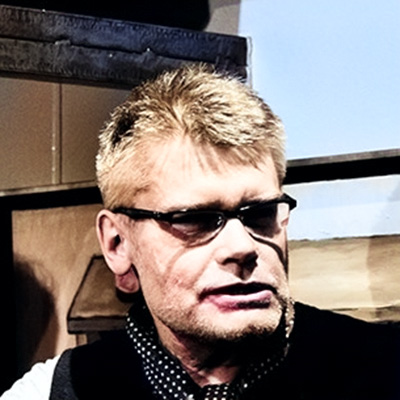
Art historian, art dealer, manager, awarded for his contribution to culture. For thirty years he managed the gallery of the Association of Polish Artists and Designers at Krakowskie Przedmieście 17.

Martyna Merkel is looking at the world. She observes, contemplates, lives. The painting is the result of her gaze, attention, sensitivity and the way she synthesises impressions on canvas. Elements of descriptiveness disappear in favour of concise construction of forms merely suggesting objectivity.
By Małgorzata Czyńska, Wojciech Tuleya
Artist: Martyna Merkel
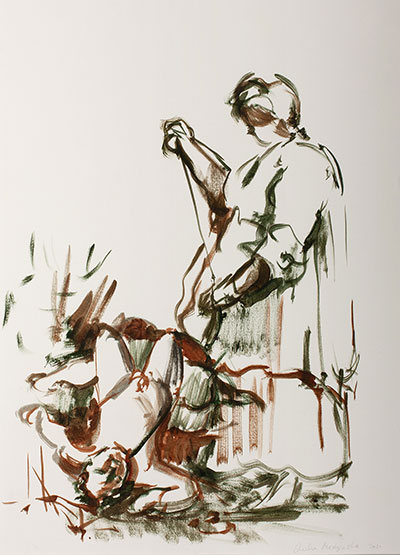
At first glance these are drawings from the museum portfolio of the old masters. Julia Medyńska draws on the achievements of her great predecessors with her usual flair and irreverence. She reaches for the stylistic means and historical costumes of past eras. She uses conté crayons, oil paints, and pencils. Beneath the historicising costumes, chilling scenes are played out, a baroque thriller.
By Wojciech Tuleya
Artist: Julia Medyńska
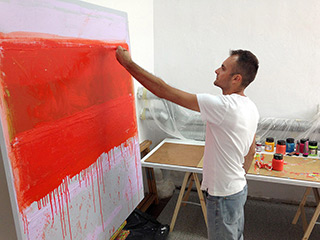
After all, nothing is so liberating, both for the artist and the viewer, as abstraction. Yes, it has roots in reality, and Sebastian Skoczylas’ paintings were also created in the process of recording reality and then synthesising it, subordinating it to the framework of composition, and now it moves more and more towards creating objects.
By Wojciech Tuleya, Małgorzata Czyńska
Artist: Sebastian Skoczylas
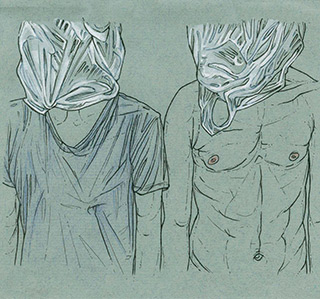
Desire, ecstasy, and suffering are the strongest moments when you become aware of your carnality, the feeling of physicality. In Magdalena Sawicka’s drawings, the physicality is present in the trickles of semen on the lips, a turgid penis, wet stains on girls’ panties, cut and bruised hands and tearful faces.
By Małgorzata Czyńska, Wojciech Tuleya
Artist: Magdalena Sawicka

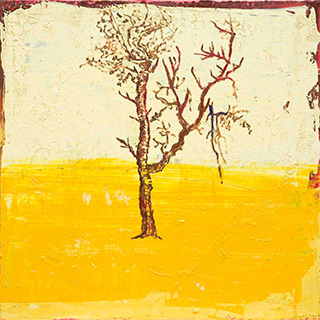
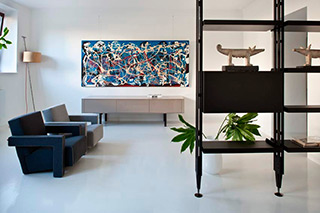
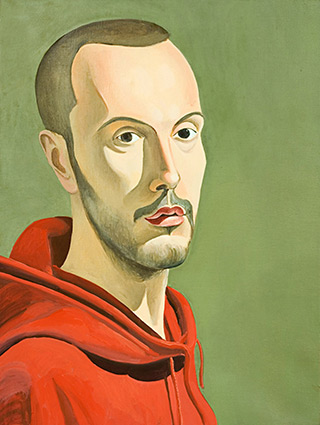
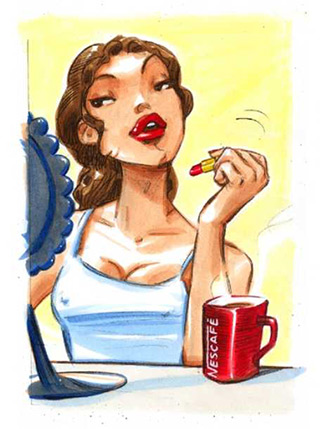
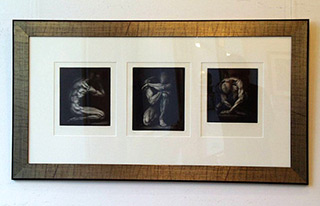
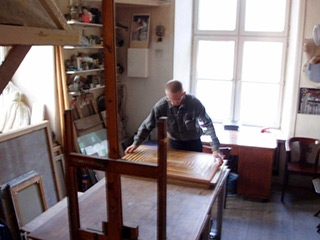

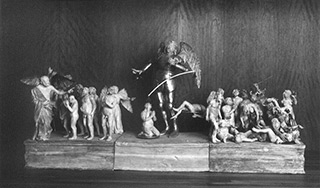

Vases are closest to the definition of a painting according to the Polish Colourists. However, Pala saturates them with emotions which do not normally go with the art of flower arrangement. His vases are rudimentary, archaic, brutal. They bear witness both to the struggle with material, so precious to Colourists, and to the painters unfailing knack for finding a colouristic punchline.
By Wojciech Tuleya
Artist: Darek Pala
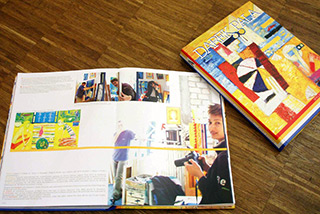
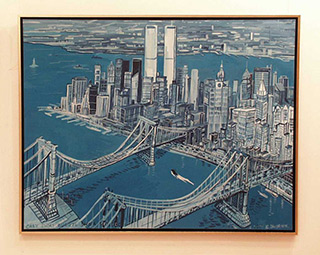
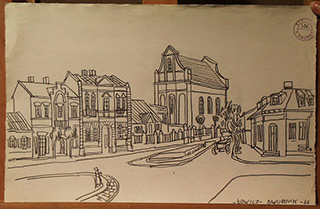
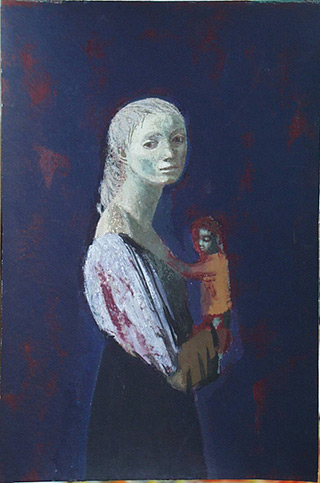
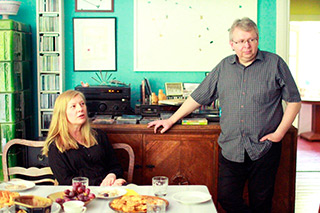
Podkowa Leśna. An old wooden house with lots of soul… Not that big, but quite spacious. There’s enough room to house pieces of art, books, a random collection of interesting objects, records and drums. Anna Podlewska, painter, and Paweł Polit, art historian and exhibition curator, are telling us its story.
Interview by Małgorzata Czyńska, Wojciech Tuleya
Artist: Anna Podlewska
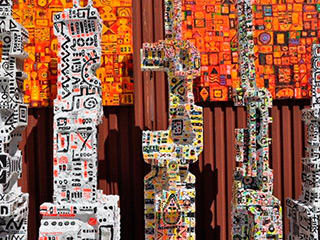
The surface of the canvas is a field of absolute artistic freedom and the same right should be reserved for the audience. In petroglyphs I can see a mystery, an area that has not been explored and discussed by experts. To my mind beauty also lies in variety, thus the mosaic of shapes and colours.
Interview by Wojciech Tuleya
Artist: Krzysztof Pająk
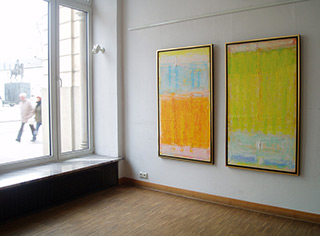
I do have impressionistic inclinations and I do like impressionism a lot, indeed, even though at first glance it may not be so noticeable in my paintings, since they are abstract after all.
Interview by Wojciech Tuleya
Artist: Sebastian Skoczylas
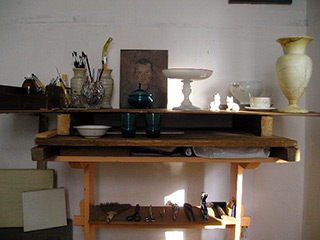
For centuries, European art was a figurative art, whilst realism was but one of 19-century artistic trends, pretty uninteresting artistically, in any case.
Interview by Wojciech Tuleya
Artist: Tomasz Karabowicz
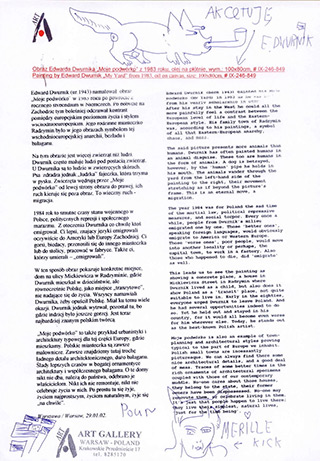
Edward Dwurnik painted his Moje podwórko (My Yard) in 1994 as he was back from his yearly scholarship in Germany. After his stay in the West he could all the more painfully feel a contrast between the European level of life and the Eastern-European style.
By Wojciech Tuleya
Artist: Edward Dwurnik
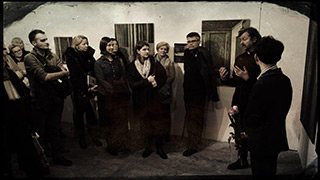
Questions to a painting: A portrait or a still life? Is it still a portrait or already a still life? Reminiscence of life, proof of human existence, or merely an object, a bone, Vanitas, end, nothing more.
By Małgorzata Czyńska, Wojciech Tuleya
Artist: Łukasz Huculak
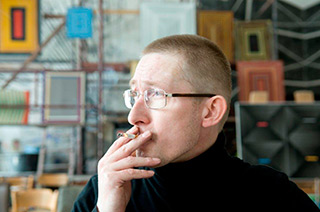
Łukasz Majcherowicz- a serious man. A serious type of painting – studied and measured. His atelier in the Warsaw Art Academy is like a meditation room, a detox after classes with youth. Students are not allowed to enter. Just by looking at these paintings one can fall into a trance, let alone painting them.
By Wojciech Tuleya
Artist: Łukasz Majcherowicz
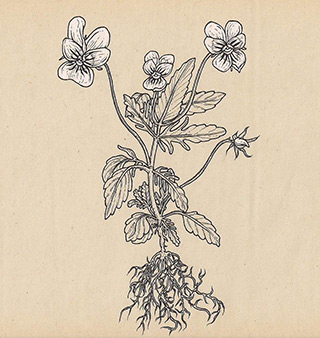
Magdalena Sawicka received the Grand Prix during the biennale Jeune Création Européenne (Young Europaen Art) held in Montrouge near Paris.
By Wojciech Tuleya
Artist: Magdalena Sawicka
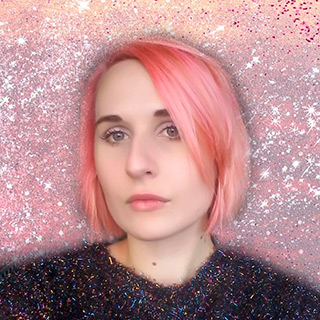
Sawicka’s courage in representing intimacy, otherness, disability or sex is not aimed at cheap effect; it is not pornography, but a modern romanticism, curiosity about and reflection on the corporeal world as an enclosed space, as well as on relations between people: a diary and sociological study rolled into one.
By Małgorzata Czyńska, Wojciech Tuleya
Artist: Magdalena Sawicka
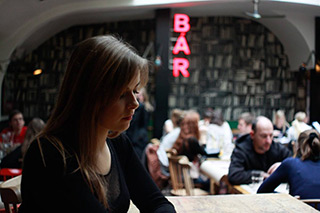
The current exhibition by Katarzyna Karpowicz in Galeria Promocyjna is entitled Ludzkie historie [“People’s stories”]. The title is very fitting, as each painting by the artist urges the viewer to guess, to build a narrative.
By Wojciech Tuleya, Françoise Sagan, Marcel Proust, Balthus, Rainer Maria Rilke
Artist: Katarzyna Karpowicz
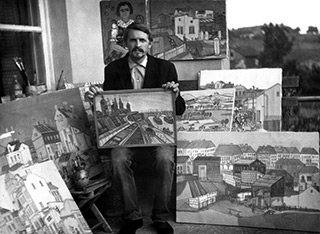
Edward Dwurnik is an indefatigable worker. His productivity is legendary. Art critics, exhibition curators and journalists alike all revel in giving the numbers of pictures he can create in a week, a month, a year.
By Małgorzata Czyńska, Wojciech Tuleya
Artist: Edward Dwurnik
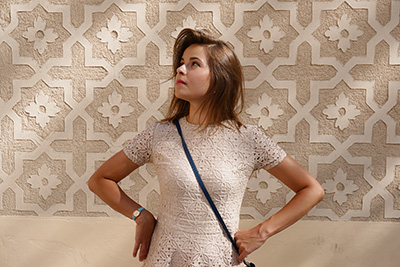
Katarzyna Karpowicz has just created an exhibition inspired by Spain, its art, colours and light, and above all lifestyle. She thrills at the paintings of El Greco and delights in the charm of being part of a community, of tolerance, gestures of closeness, the skill of celebrating moments, of living everyday life to the fullest.
By Małgorzata Czyńska, Wojciech Tuleya
Artist: Katarzyna Karpowicz
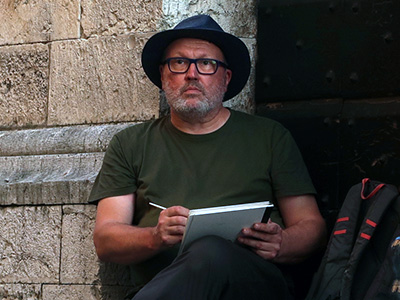
A Roman holiday in the middle of winter? Krzysztof Kokoryn brings to life dreams of sunshine, beauty and the Italian lifestyle. Instead of a plane ticket, a series of Roman paintings.
By Małgorzata Czyńska, Wojciech Tuleya
Artist: Krzysztof Kokoryn

Jacek Łydżba loves, wants love, paints the hunger for feeling, paints the state of rapture. In each female portrait, he encloses a universe of feelings, experiences, promises. There are scores of female faces on the sheets of music, and each one is the face of a beloved, for whom the heart of the painter and the viewer beats.
By Małgorzata Czyńska, Wojciech Tuleya
Artist: Jacek Łydżba
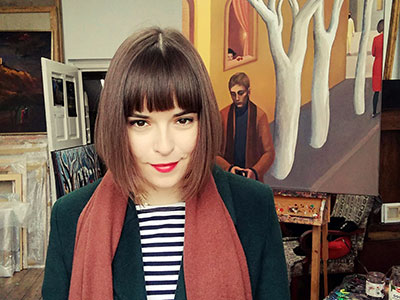
In Katarzyna Karpowicz’s paintings, feelings and dreams, literature and cinema, reality and unreality, are combined in a seductive narrative, full of subtle wit and light nostalgia.
Life is elsewhere, perhaps in the painting.
By Małgorzata Czyńska, Wojciech Tuleya
Artist: Katarzyna Karpowicz
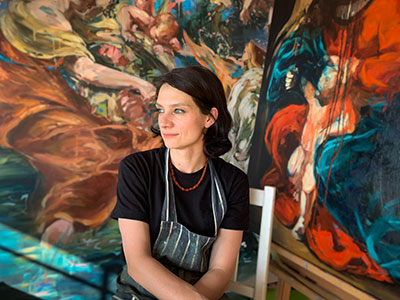
To meet the painter Julia Medyńska, we went all the way to Międzyrzecz, in the middle of summer. We were driven by unbridled curiosity. We knew very little, only that recently, after years spent in Berlin and New York, she had suddenly landed right in Międzyrzecz, that she was an actress. Everything looked very intriguing and mysterious.
By Małgorzata Czyńska, Wojciech Tuleya
Artist: Julia Medyńska
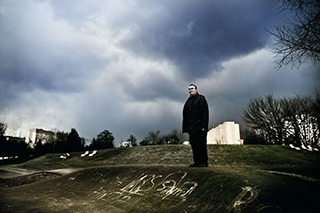
A man from outside the community, untrained, an amateur, self-taught, whatever you want to call it. In any case, a non-professional artist who wanted to see if he measured up to the professional world of art. After all, who said that the lack of a formal education is an obstacle?
By Małgorzata Czyńska, Wojciech Tuleya
Artist: Wiktor Gorazdowski
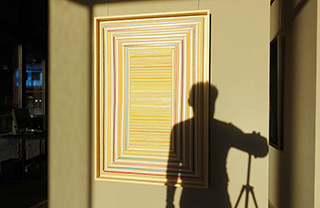
The presentation of Łukasz Majcherowicz’s works from the Windows cycle is yet another exhibition without an audience at the Galeria Art. After a year of living in isolation, after “the year that wasn’t”, after months full of fear, sadness and hope, these paintings – personal records of the artist’s emotions – acquire a universal character: in them, as in mirrors or windows, our feelings are reflected.
By Wojciech Tuleya
Artist: Łukasz Majcherowicz
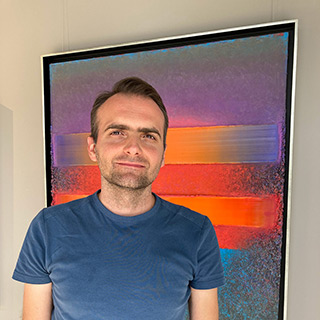
It needs to be said straightforwardly: the hands practically itch to get at these paintings. You want to touch them, slide your hand over the smooth shiny strip of paint, like it was the paint of a luxury car of the surface of a designer fridge, accidentally brushing against a rough surface that’s happening farther on and feel more, dig in the grooves of colour, like in hardened plasticine.
By Wojciech Tuleya, Małgorzata Czyńska
Artist: Sebastian Skoczylas

In Katarzyna Karpowicz’s paintings, art and medicine intertwine into an inseparable magical story, medicine becomes magic, and the personal experience of illness and recovery makes the story touchingly true.
By Małgorzata Czyńska, Wojciech Tuleya
Artist: Katarzyna Karpowicz
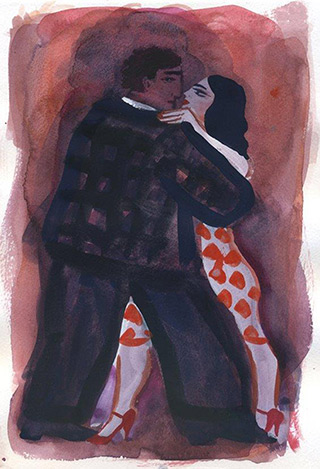
The theme of this exhibition is the tango, the most sensuous dance in the world. Seductive, sexy, filled with desire and jealousy, a desire for power, the wish to dominate the partner but also a longing for love and intimacy. He and she, the story that unfolds between them on the dance floor for a few moments.
By Małgorzata Czyńska, Wojciech Tuleya
Artist: Krzysztof Kokoryn
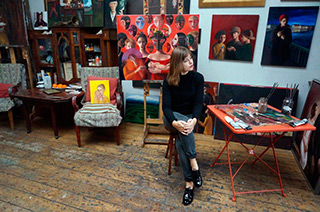
In Katarzyna Karpowicz’s works, the painting is always the result of deeply experiencing reality, of observations and feelings. The seemingly unreal scene flows from events, meetings and conversations. Life experiences give rise to new painting series.
By Małgorzata Czyńska, Wojciech Tuleya
Artist: Katarzyna Karpowicz

The labyrinth is a recurring theme in Łukasz Majcherowicz’s art. With each painting the artist ventures deeper on the journey into his unconscious, down the byways of reality. He tries to understand himself and the world. He poses questions but offers no answers.
By Małgorzata Czyńska, Wojciech Tuleya
Artist: Łukasz Majcherowicz
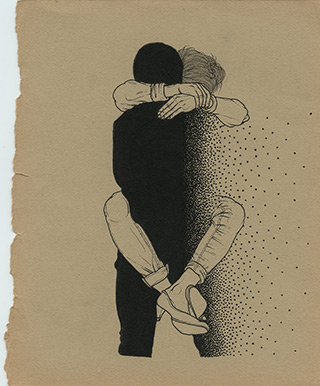
The tone of Magdalena Sawicka’s drawings is personal; the artist herself declares that there is no such thing as a communal sensitivity; each person has their own experiences, thoughts, feelings; and even when she draws inspiration from the global internet community, she interprets the existing interpretations.
By Małgorzata Czyńska, Wojciech Tuleya
Artist: Magdalena Sawicka
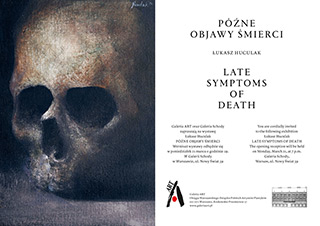
Divagations on art and death. For a long time, Huculak believed that the gravity of a skull – this crown of still life – is inevitably suffused with the grotesque. For years he would treat painting skulls as a painter’s training, almost meditational, until the motif grew in strength and the painting reached the appropriate state of matter. The existential burden and the chill of constructivism merged into a painting.
By Małgorzata Czyńska, Wojciech Tuleya
Artist: Łukasz Huculak
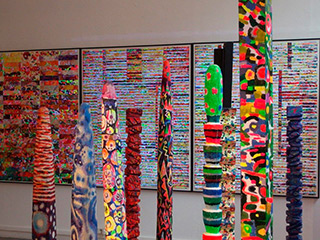
The paintings by Krzysztof Pająk begin where the light is about to stop. At first, there is the dive into the abyss – the big blue, navy blue – almost blackness, darkness. Next comes the experience of a brand new world of coral reefs. A revelation, a fairytale, a day-dream, the pulsation of colour, and sensuality so different from the one on the surface.
By Wojciech Tuleya
Artist: Krzysztof Pająk
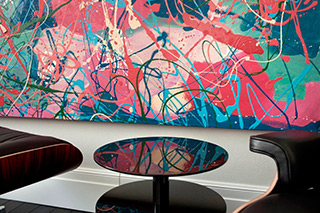
The majority of the exhibited paintings would not fit in your homes. The smallest canvases are of 2 metres in height and, thus, we could merely pack thirty eight of these in the 800 square metres of the exhibition hall. Series No 25 alone consists of over 300 paintings, most of which were painted within 6 years. That means almost 50 large-format canvases a year! And at the same time Edward Dwurnik was developing his other series of paintings.
By Małgorzata Czyńska, Wojciech Tuleya
Artist: Edward Dwurnik
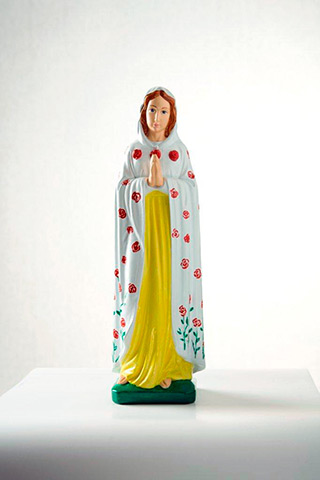
Jacek Łydżba treats religious symbols without any rebellion, personal disagreement or excessive rigour. As befits a pure-blood artist, he has his own vision and his own expression. He takes those gypsum figurines and dresses them up with garments in strong and expressive colours, emphasising their beauty and kitsch.
By Małgorzata Czyńska, Wojciech Tuleya
Artist: Jacek Łydżba
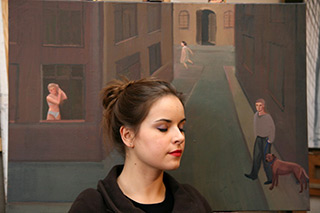
An atelier full of paintings – of life and dreams. No devising – intuition instead. There is no need to devise things as themes, since ideas just pop up on their own. And most often in sleep. Everyday life is reflected in dreams, and dreams can see themselves in the paintings.
By Małgorzata Czyńska, Wojciech Tuleya
Artist: Katarzyna Karpowicz
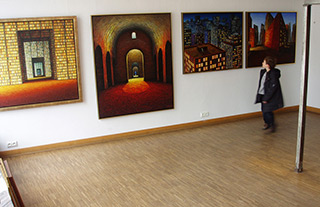
When provincial Częstochowa is getting ready for bed, the painter – locked in his small flat – suffering from insomnia, has to work. He is painting a metropolis, big city lights, the city that never sleeps.
By Wojciech Tuleya
Artist: Adam Patrzyk
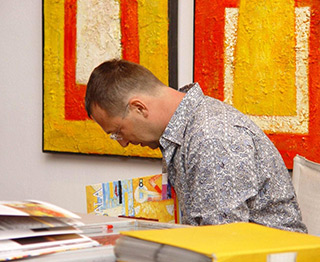
It was 13 years ago that Darek first walked into the gallery I run. He was a young graduate of the Cracow Academy of Fine Arts then. I soon realized that collaboration with this artist would go far beyond the ordinary partnership of artist and gallery.
By Wojciech Tuleya
Artist: Darek Pala
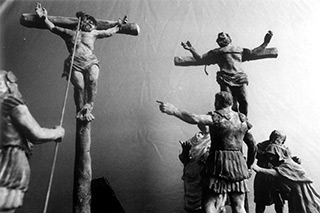
There are several reasons for which I have decided to show you some sculptures by Leszek Jasiński.
By Wojciech Tuleya
Artist: Leszek Jasiński
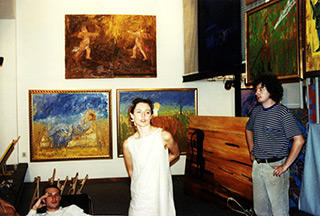
We long for provincial life: life that runs slowly, with quiet and unassuming happiness. Perfect provincial life exists in books by such authors as Bruno Schulz or William Faulkner. During a journey it may seem for a while that we see it from the train window.
By Wojciech Tuleya
Artist: Jacek Łydżba

Hawker Fury. The name was coined to add, or inspire, terror. In reality, the machine’s structure was tiny and rather delicate. The gentlemen who mounted it used to paint coloured chequered patterns on it. As if the plane was not supposed to fight, but rather, to race. These days, in the time of those flying buses, Hawker Fury’s shapely silhouette evokes nostalgic associations: with the ‘retro’ age indeed, the one of The English Patient, or, Farewell to Africa. But then, it did seem futuristic. Elegant, and cold. Pilots used to like Hawker Fury but treated it with respect, considering it to be an elitist plane.
By Wojciech Tuleya
Artist: Jacek Łydżba
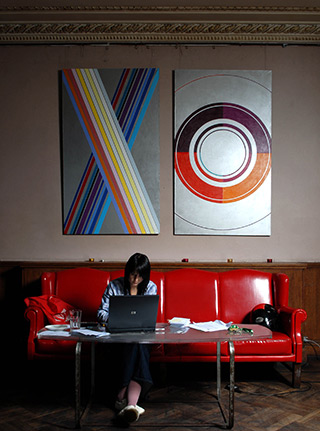
Małgorzata Jastrzębska has rejected picturesque-ness of orphism. Her forms have sharp edges – one can tell she uses a masking tape when painting to make the separation of the colours unequivocal and definite. Although she paints with a soft brush and oil paints it looks as if she was using a compass and a scalpel. There are mathematics and physics textbooks on the table in her studio.
By Wojciech Tuleya
Artist: Małgorzata Jastrzębska
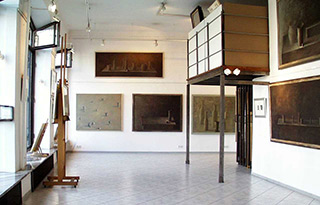
I’ll never forget Łukasz’s first visit to our gallery. Two years ago he came in, straight from the street, just like that, with a sheaf of paintings under his arm. When he opened the portfolio and arranged an impromptu exhibition on the floor, I knew immediately that I wanted the pictures to stay. I couldn’t believe their author was just 24 years old. I had in front of me that rare phenomenon, early work which is already mature.
By Wojciech Tuleya
Artist: Łukasz Huculak
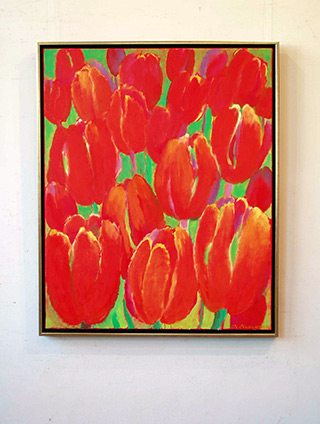
I first saw her tulips in 1992, in a small pub at Podkowa-Leśna. The painting hanged on the wall of a dark corridor, between the kitchen and the restroom. Next to the tulips, a sad cloakroom attendant was seated, unable to see that behind his head, the gate to a paradise was opening.
By Wojciech Tuleya
Artist: Beata Murawska
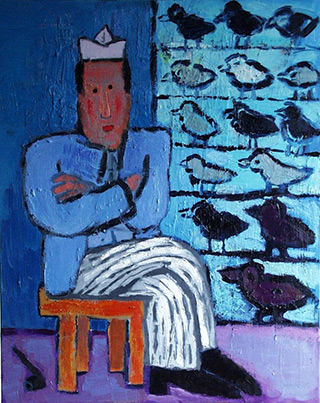
I am a busy man and don’t quite much socialise with others. So when I recognised my own self in a picture by Kokoryn, I was astonished. To get portrayed by Kokoryn has been a privilege o musicians, vagabonds, storytellers sitting around joints, or, young girls; at least this is what I always thought.
By Wojciech Tuleya
Artist: Krzysztof Kokoryn

Krzysztof Kokoryn’s manners are that of an anarchist. Yuppies from all over Europe are crazy about his paintings, indeed, but to be invited by any of them to a chic dinner - he wouldn’t accept such kind of things. He’d reject it in favour of a glass of beer in a cheap pub in a company of the Academy students and friends - the maudits, misunderstood by the middle class.
By Wojciech Tuleya
Artist: Krzysztof Kokoryn
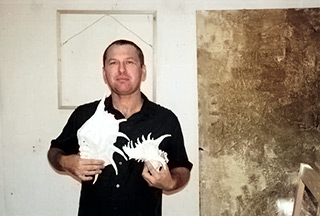
It was a year ago that Darek Pala first put up his easel in front of his aquarium. Instead of going on an exotic trip or just diving into the nearby ocean, he set up a home aquarium and started painting what he saw in it.
By Wojciech Tuleya
Artist: Darek Pala
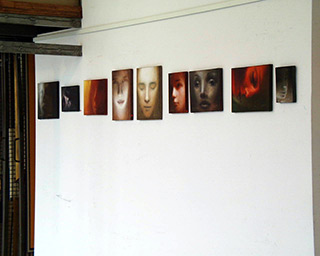
Adam Korszun likes to paint portraits. Their main characters are Girls – that is, closer and farther acquaintances of the artist, friends, dwellers of Biała-Podlaska. Adam conducts a never-ending casting session in his native town.
By Wojciech Tuleya
Artist: Adam Korszun
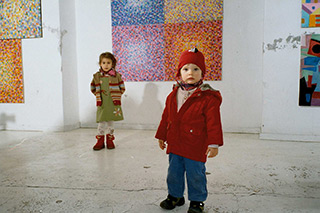
Zofia Matuszczyk-Cygańska has just turned ninety of age. But her exhibition Colour games is not an occasional hand-made birthday greetings card. Although it is but one of some three hundred exhibitions in which she has taken part, it is an unique event indeed.
By Wojciech Tuleya
Artist: Zofia Matuszczyk-Cygańska
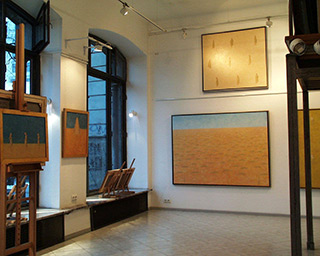
Here is a list of activities in which the heroes of Mikolaj Kasprzyk’s paintings engage: playing tag, dancing, chasing birds, tight-rope walking, skipping, juggling.
By Wojciech Tuleya
Artist: Mikołaj Kasprzyk
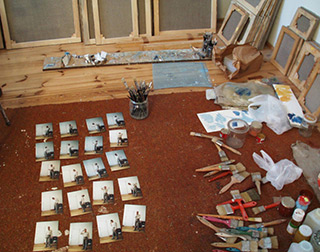
A sketch, study, is one of the artist’s work stages. Before the final version of a work-of-art is produced, initial drawings of individual figures, objects, or landscape are needed. Such a work only emerges if and when those components get merged.
By Wojciech Tuleya
Artist: Mikołaj Kasprzyk
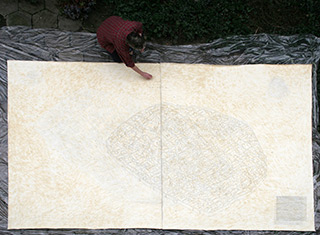
Jolanta Wagner’s art is simultaneously archetypal and modern. Her drawings’ primal essence contains a feminine-like monotonous weaving – a spider’s web of seemingly mechanically recorded events, thoughts and objects organized within a clearly legible system.
By Wojciech Tuleya
Artist: Jolanta Wagner
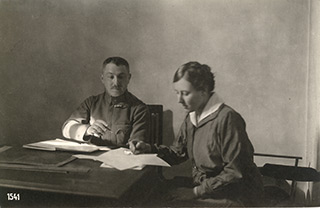
A few years ago one of my acquaintances, a modern art and historic objects collector, showed me his last trophy he had bought from a Viennese antique dealer. It was a collection of old photographs. Over the several evenings that followed, we watched them together through a magnifying glass, scanned them producing maximum blowups so that we could see any and all details. It was fun, to an extent, but we wanted to solve the puzzle on the occasion.
By Wojciech Tuleya
Artist: Bogna Gniazdowska
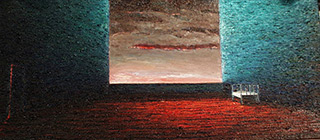
The Universe has perhaps not ceased to expand, but Adam’s Cosmos has long ago shrunk, assuming a safe size. For Adam, the horizon of Being is set forth by the floor-area of his bachelor flat. And it is within these confines that Adam amends the Creation.
By Wojciech Tuleya
Artist: Adam Patrzyk
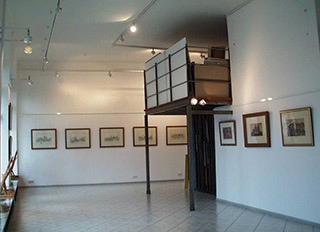
Edward Dwurnik painted his Moje podwórko (My Yard) in 1985 as he was back from his yearly scholarship in Germany. After his stay in the West he could all the more painfully feel a contrast between the European level of life and the Eastern-European style. His family town of Radzymin was, according to his paintings, a symbol of all that Eastern-European anarchy, chaos, and mess.
By Wojciech Tuleya
Artist: Edward Dwurnik
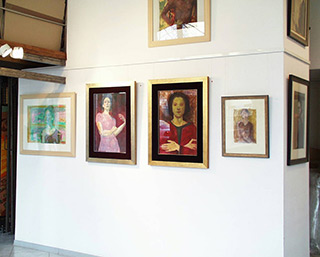
When I first saw Aleksandra Waliszewska’s self-portraits, painted on scraps of cardboard, I felt as if I had blown off the dust covering a real treasure.
By Wojciech Tuleya
Artist: Aleksandra Waliszewska
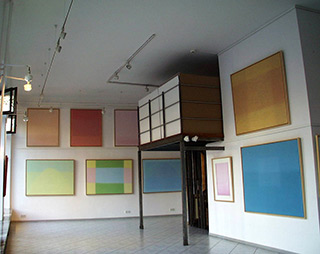
The paintings by Anna Podlewska: hermetic for some, whilst spontaneous and childishly easy for others. Whether the promise expressed in the exhibition’s title may be kept, will only depend upon ourselves.
By Wojciech Tuleya
Artist: Anna Podlewska
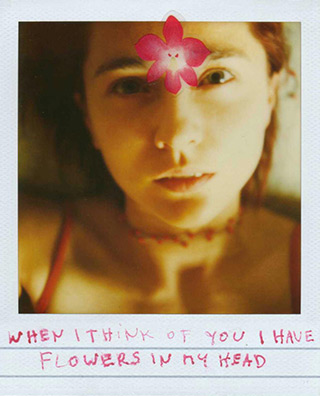
To be an artist in our times is to travel. The starting point of Agnieszka’s travels was her studio in her parents’ home in Gdynia. The house stood on a cliff over the sea. The studio, like studies in Romantic villas, had windows on four sides. One only had to lean out a bit further and set off on a journey.
By Wojciech Tuleya
Artist: Agnieszka Brzeżańska
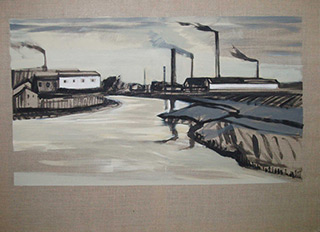
What Maria Kiesner paints is townscapes. This classic painting genre has urban landscape and architecture as its topics. But Maria’s paintings tell us that architecture is not only there around us. It is also within us.
By Wojciech Tuleya
Artist: Maria Kiesner
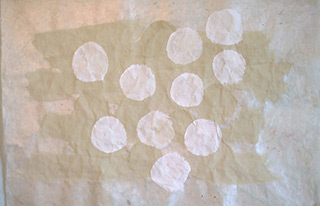
Ciro Beltrán has something about himself which is called obsession by some, or mission by others. While talking to people, he would often mention ”hiding” and ”discovering”. He strives for discovering the truth, the one spelled with a block ”T”.
By Wojciech Tuleya
Artist: Ciro Beltrán
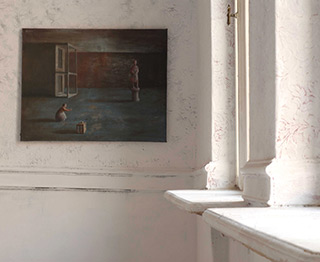
The title of this exhibition is a number. MMVI in Roman numerals stands for the year 2006. Although 2006 is the date of creation of all the paintings presented at this exhibition, indifference of their creator toward any problems of the year 2006 is his firm manifesto.
By Wojciech Tuleya
Artist: Łukasz Huculak
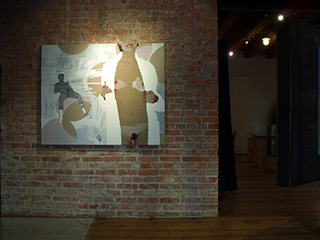
For Agnieszka Sandomierz, as for several artists of her age, the starting point is a new pop-art. This can be seen in the frames of her paintings, in how substantive and ordinary they are. However, Agnieszka’s paintings exceed the limits of an impersonal pop-art. They tend to omit its rigours, rather than overcoming them.
By Wojciech Tuleya
Artist: Agnieszka Sandomierz
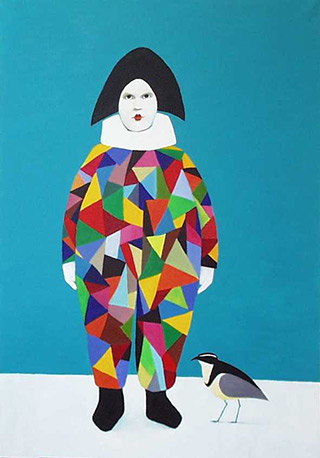
Katarzyna Castellini’s paintings is not a report from a trip to Italy. It used to be one, though, some time ago. But the report was rather strange. The artist is an intelligent observer; she has recorded in her paintings many scenes and characters of Italian provenance.
By Wojciech Tuleya
Artist: Katarzyna Castellini
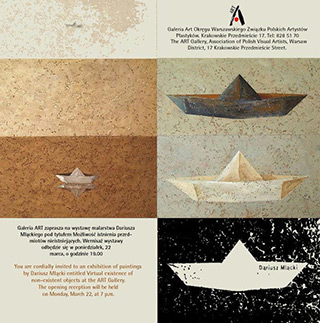
Darek Mlącki, the most sought-for wall-painting and trompe-l’oeil specialist, was just finishing the work commissioned at a residence off Warsaw. He was painting frescos inside a swimming-pool building. Suddenly, someone jogged the bucket and a beet-colour painted got spilled over the beautiful travertine wall cladding, imported all the way from Italy. This was a disaster.
By Wojciech Tuleya
Artist: Dariusz Mlącki
